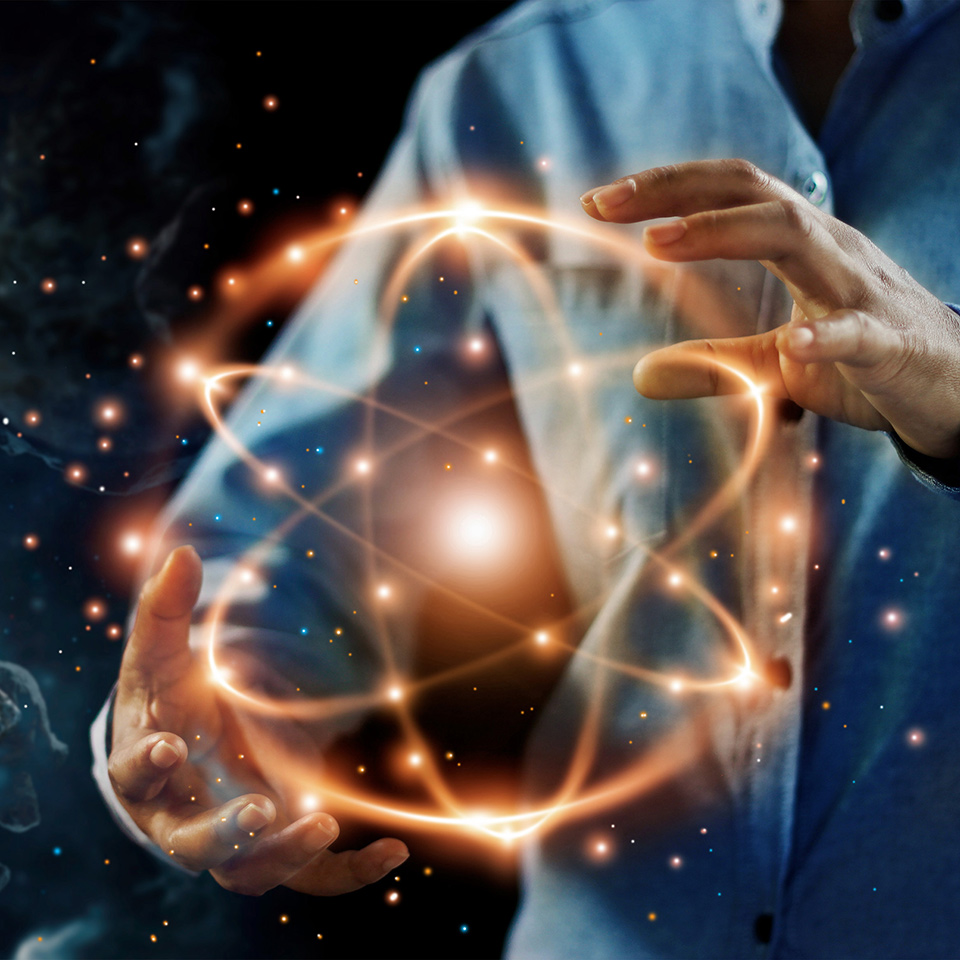The words "Quantum physics" and "the basics" might not seem like they belong in the same sentence but, despite its reputation for complexity, Quantum physics has some basic principles. These building blocks within the subject also happen to form the foundation of our world, which is why we’re going to explore them in this article!
Jump to:

What is Quantum Physics?
Quantum physics (often referred to as Quantum mechanics) is a branch of Physics that explores the behaviour of matter and energy at the smallest possible scales.
It’s not quite the same as the physics that we know and learn at school, and many people therefore ask the question “But how does quantum physics differ from classical physics?”
Essentially, the key distinction lies in its treatment of nature. Classical physics (the physics we did at school) describes the everyday world, from the motion of planets to the mechanics of machinery. However, as we zoom into the microscopic world of atoms and particles, classical physics starts to falter. That’s where Quantum physics steps in to reveal the extraordinary behaviour of these tiny entities.
There are two fundamental concepts of quantum physics: quantisation and wave-particle duality.
Quantisation reveals that energy and matter come in discrete, quantised units rather than continuous values. On the other hand, wave-particle duality introduces the notion that particles like electrons and protons can behave as both particles and waves simultaneously, depending on how they are observed.
Recommended for you!
Best SellersThe Quantum World
Diving into quantum physics means delving into a world that's a bit like Alice's Wonderland, where everything operates on a completely different scale from what we're used to in our everyday lives.
At one end of the spectrum, we have the tiniest building blocks of nature: subatomic particles. These are the minuscule particles - like electrons, protons, and quarks - that form the foundation of matter. On the other end, we have the vast expanse of the universe, with galaxies, stars, and planets all governed by the same quantum principles. Quantum physics therefore doesn't just apply to the small stuff: it's the rulebook for the entire cosmos!
There is also something called “Planck’s constant”. This constant is the key to understanding the quantum world. It tells us that nature works in tiny, discrete chunks – like pixels on a screen, but for the universe. These chunks are so small that it's hard to even imagine, but they're the very fabric of our existence.
Quantum Mechanics - The Fundamental Principles
There are three fundamental principles that form the backbone of Quantum mechanics (Quantum physics). These are:
Superposition
Imagine you have a magical coin. In the classical world, it's either heads or tails when you flip it. But in the quantum realm, this coin can exist in a sort of in-between state, both heads and tails at the same time, until you look at it. This simultaneous existence of multiple possibilities is what we call "superposition." One way to look at it is that the coin is a magician and its trick is to be in all states until someone catches it in the act.
Entanglement
Now, picture two magical coins that are entangled, no matter how far apart they are. When you look at one, the other instantly knows what's happening, and it changes its state accordingly. This connection is called “entanglement”. It's like there’s a telepathic link between these coins, and it's one of the quantum world's most incomprehensible features.
Observations and Uncertainty
In the quantum world, the act of observing something can change its behaviour. The best way to describe this is to imagine that you have a shy cat. The moment you take a peek at it, it might act differently. This is what “uncertainty” is: you can’t precisely predict a particle's position and momentum at the same time.

Schrödinger's Cat and Probability
Staying on the topic of cats, you’ve probably also heard of Schrödinger's Cat.
The term "Schrödinger's cat" was created by the Austrian physicist Erwin Schrödinger in 1935 as part of an experiment he devised to illustrate the strange nature of quantum superposition (like the coin we mentioned earlier). In his imaginary experiment, a cat is placed in a sealed box, along with a radioactive atom, a Geiger counter, and a vial of poison.
Essentially this is the setup: The radioactive atom has a 50% chance of decaying within a specific time frame. If it decays, the Geiger counter detects it, breaking a vial of poison, which would then harm the cat. However, if the atom doesn't decay, the cat remains unharmed. But the interesting bit is this; according to the principles of quantum superposition, until we open the box and observe it, the cat exists in a strange state where it’s both dead and alive at the same time. Even though the cat experiment is imaginary, it does illustrate how, until observed, particles can exist in multiple states at once.
It all relates to probability. Imagine a quantum crystal ball that holds all the possible states that a particle can exist in. When we actually observe or measure that particle, the wave function collapses, revealing just one of those possibilities. So we’re always dealing with likelihoods and chances rather than definite answers. It is this concept of the wave function that quantum physicists are trying to decipher.
Particles and Waves
We’ve all come across particles before (such as electrons, protons, and carbon atoms) but things are never as straightforward in the world of quantum physics. In quantum physics, particles possess a mysterious dual nature. They can behave as both particles and waves: our aforementioned concept of wave-particle duality.
One of the most famous experiments that showcases this wave-particle duality is the double-slit experiment. Imagine shining light through two narrow slits onto a screen. Obviously in our classical, everyday world, we'd expect two distinct lines or patterns to appear on the screen, but when it comes to the quantum realm that’s not the case! The particles don't just act like individual particles: they also create an interference pattern like waves on the screen. This simple experiment clearly demonstrates that particles, such as electrons, can exhibit both particle-like and wave-like behaviour simultaneously.
In this article, we’ve only scratched the surface of quantum physics, so if you’re intrigued to learn more and explore deeper into the realms of quantum theories, general relativity, string theory, and more, consider enrolling in our accredited Quantum Physics Diploma Course, available for only £29 (save £118)!












